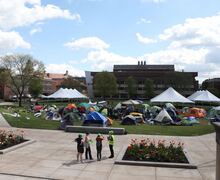Breaking the mold: SU professor hopes initative will build positive spirit in Syracuse’s Westside
When Marion Wilson thinks of the house at 601 Tully Ave., she constantly recalls a wooden ramp.
Sure, she also remembers how, for the past two years, she’s devoted almost all of her energy into revitalizing the once-decrepit house in Syracuse’s Westside. She also knows that instead of housing drugs, the building is now a hub for employment, education and community integration.
But she keeps coming back to that ramp. And more importantly, how that ramp was built to the entrance of 601 Tully just a few weeks ago in a joint effort by 2009 Syracuse University alumnus Zach Seibold and a Syracuse resident from the combined Near Westside Initiative, NorthUp and State University of New York College of Environmental Science and Forestry’s workforce program.
As Seibold taught the resident carpentry skills, a group of other Syracuse residents walked by and asked the workforce employee what he was doing, Wilson said. With a grin on his face, he replied, ‘I’m working.’
‘Zach said they felt a sense of pride. It was nice to see some of the community members come in and do some of the building with university employees,’ Wilson said. ‘I think he was really moved by the experience, that he would have someone to teach.’
Wilson has recruited students for the past four semesters with her ‘601 Tully: Social Sculpture’ class. Meeting every week down Tully Avenue, the class has refurbished almost all of the building.
This theme of integration is what Wilson, an associate professor and director of community initiatives in the visual arts at SU, has pushed during 601 Tully’s entire construction process, which will be revealed in the house’s official opening by the end of this semester. This integration is not just between the university and the community, but across all disciplines at SU, Wilson said.
Wilson said the class originally attracted only architecture and art students, and now includes English and geography majors. But Wilson said it does not matter what the student’s major is. Since the class is interdisciplinary, she said any skill is manifested within the project.
However, the wide breadth of majors presents one of the biggest challenges for Wilson. Sometimes, she said, it’s difficult to find a text or lesson that applies to everyone in the class.
‘We don’t necessarily have a shared vocabulary, like if you’re trying to talk about color or design principles, not everyone knows the same things,’ Wilson said. ‘So through readings, we try to find that.’
As important as student collaboration is, it is only one piece of the larger production. To gain as many perspectives as possible, the class reached out to members of the Westside community and Fowler High School, which sits directly across the street from the brightly painted 601 Tully house.
Samantha Harmon, a teaching assistant and 2009 SU alumna once in Wilson’s ‘601 Tully’ class, works with students from Fowler, gaining insight on their vital opinions regarding the house’s placement within the community. Harmon remembers a time when they discussed planting vines for the fence by the building. A student from Fowler said if there were vines, it would resemble the unattractive, overgrown fences within the community.
‘He conceptualized the work in a context specific to the area,’ Harmon said. ‘He was the only one who could talk about the project as a member of the neighborhood. He had that unique perspective that helped out a lot.’
Community input, in fact, is what led to the very functions of 601 Tully. Wilson said when she first began the project, she spoke with the Westside community about what they wanted in the neighborhood. The largest responses were for employment opportunities and a coffee shop.
This is what intrigued Matt Godard, owner of Café Kubal. When Wilson approached Godard about expanding his Syracuse coffee shop down to the Westside, he became excited about the positive impact it could have there. To him, a coffee shop provides the social glue some neighborhoods need to form an actual community. Additionally, Godard will teach certifiable barista lessons to students and residents in the community, increasing their chances at finding a job.
As 601 Tully approaches its opening, Wilson faces the launch with relief. Recalling the stripped-down building with boarded windows that 601 Tully was just two years ago, she said she is thrilled that all of her and her students’ work, which she found ‘harder than motherhood,’ has finally come to fruition. Whether she’s touching up the house’s art gallery upstairs or adding a ramp to the building, she has found this semester extremely rewarding.
‘Every time we make a big move like that, we’re able to say all that conversation and design dialogue we had is now being seen,’ she said.
That relief, however, is met with a hint of anxiousness. Once 601 Tully officially opens, its lifespan and vitality will be the community’s responsibility. While Wilson is requesting the university to find someone who can look after the building, no decision has been made. Though, if 601 Tully can give an economic and social jolt to the Westside neighborhood, she and Godard see it as a symbol of optimism for the community.
‘People need hope,’ Godard said. ‘And something that is creating jobs is a positive impact. It gives hope, which is critically important in an area like Syracuse.’
Published on March 27, 2011 at 12:00 pm




